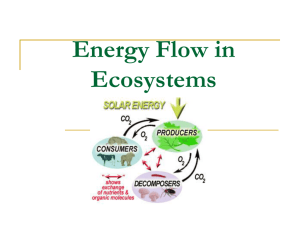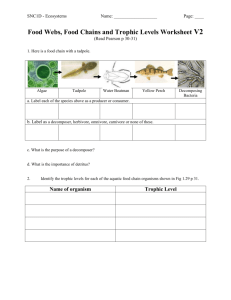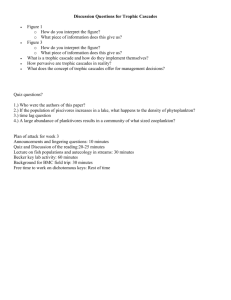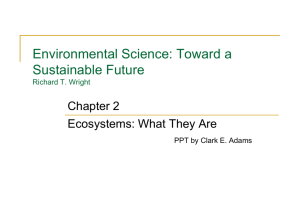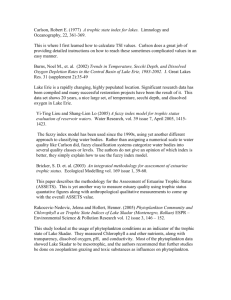Final Exam Study Guide
advertisement
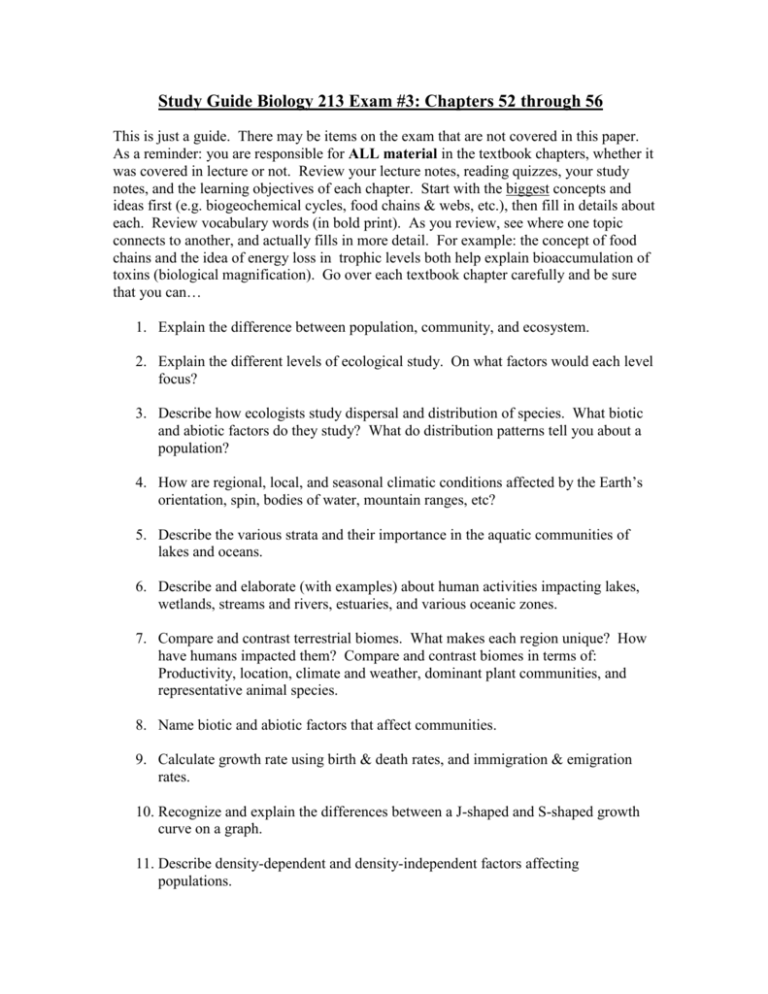
Study Guide Biology 213 Exam #3: Chapters 52 through 56 This is just a guide. There may be items on the exam that are not covered in this paper. As a reminder: you are responsible for ALL material in the textbook chapters, whether it was covered in lecture or not. Review your lecture notes, reading quizzes, your study notes, and the learning objectives of each chapter. Start with the biggest concepts and ideas first (e.g. biogeochemical cycles, food chains & webs, etc.), then fill in details about each. Review vocabulary words (in bold print). As you review, see where one topic connects to another, and actually fills in more detail. For example: the concept of food chains and the idea of energy loss in trophic levels both help explain bioaccumulation of toxins (biological magnification). Go over each textbook chapter carefully and be sure that you can… 1. Explain the difference between population, community, and ecosystem. 2. Explain the different levels of ecological study. On what factors would each level focus? 3. Describe how ecologists study dispersal and distribution of species. What biotic and abiotic factors do they study? What do distribution patterns tell you about a population? 4. How are regional, local, and seasonal climatic conditions affected by the Earth’s orientation, spin, bodies of water, mountain ranges, etc? 5. Describe the various strata and their importance in the aquatic communities of lakes and oceans. 6. Describe and elaborate (with examples) about human activities impacting lakes, wetlands, streams and rivers, estuaries, and various oceanic zones. 7. Compare and contrast terrestrial biomes. What makes each region unique? How have humans impacted them? Compare and contrast biomes in terms of: Productivity, location, climate and weather, dominant plant communities, and representative animal species. 8. Name biotic and abiotic factors that affect communities. 9. Calculate growth rate using birth & death rates, and immigration & emigration rates. 10. Recognize and explain the differences between a J-shaped and S-shaped growth curve on a graph. 11. Describe density-dependent and density-independent factors affecting populations. 12. Review various experiments & studies described in each chapter and the lecture notes (e.g. Moose and wolf populations; acorns, mice & deer, and Lyme’s disease; eutrophication and phosphates in Ontario lakes, etc.). 13. Distinguish between r-selected & k-selected populations and Type I, II, & III survivorship trends. 14. Know and explain various factors that impact (positively and negatively) human population trends – especially factors that have caused exponential growth in the past 150 years. 15. Be able to define and explain the importance of the term “carrying capacity.” and how it affects populations. 16. Describe and give examples from the different trophic levels: producers, primary, secondary, & tertiary consumers, decomposers & detritivores. 17. Differentiate between “habitat” and “niche.” Also “dominant species” and “keystone species.” 18. Explain and give examples of different symbiotic relationships: mutualistic, commensalistic, predator/prey, and parasitic. 19. Name and explain limiting factors that can affect communities. 20. Recognize, identify and describe: i. Primary vs Secondary succession. ii. Successional stages and representative organisms / communities. iii. Ecotones and Edge zones and their importance. 21. Describe beneficial effects of fire on communities. Give several examples. 22. Compare and contrast various types of relationships in a community: competition, predation, symbiosis and explain various results in population dynamics that can occur from each type of interaction. 23. Compare and contrast Batesian and Mullerian mimicry, camouflage, co-evolution, and all of the various types of symbiosis. 24. Explain biodiversity and how this is used to measure the health of an ecosystem. 25. Describe the effect of human activities on ecosystems: a. deforestation b. nutrient enrichment c. acid precipitation 25. Describe the effect of human activities on ecosystems continued: d. biological magnification (bioaccumulation) and toxins e. Greenhouse gases (all of them) and Global warming f. Depletion of the ozone layer 26. Diagram and describe how energy moves through a community using food chains, webs, and trophic level pyramids (energy, biomass, & numbers). 27. Compare and contrast how energy and matter (mass) move through terrestrial and aquatic ecosystems. Define primary producer, primary, secondary, and tertiary consumers, and detritivores. 28. Compare and contrast gross and net primary production, and explain how energy limits each trophic level (trophic efficiency). What is the energy loss at each trophic level? 29. Diagram and give detailed explanations for the following four biogeochemical cycles: a. Carbon b. Nitrogen c. Hydrologic d. Phosphorus.
